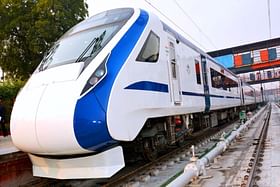Faced with low occupancy rate in some Vande Bharat trains, the Railways is planning some changes in routes and composition of the trains to make the premier service commercially viable.
According to the plan, some 16-coach Vande Bharat trains having less occupancy rate would be reduced to 8-coach service and on the other hand the 8-coach trains which are running with over 100 per cent occupancy rate would be equipped with more coaches.
Currently 15 pairs of Vande Bharat trains are operational with the occupancy rate ranging between 48 per cent and 203 per cent in April.
The 16-coach Bilaspur-Nagpur Vande Bharat train is having 52 per cent occupancy rate and the Nagpur-Bilaspur service is showing 57 per cent occupancy rate.
We are planning to reduce the 16-coach train to 8-coach in the Nagpur-Bilaspur-Nagpur sector, a senior Railway official informed.
Similarly, the 8-coach Secunderabad-Tirupati-Secunderabad Vande Bharat Express is showing housefull since its inaugural service.
As per the plan, the number of coaches would be increased to 12 or 16 in the sector to cater to the increasing number of pilgrims.
According to the occupancy chart, Ajmer-Delhi Cantonment Vande Bharat service is having 48 per cent occupancy rate and the return journey is showing 73 per cent occupancy rate.
The train is reaching Delhi Cantonment from Ajmer at 11.35am in the morning while leaving Delhi at 6.40pm for its return journey to Ajmer and as a result the train is lying idle for about seven hours in Delhi.
The Railways is now exploring to start a special service for Agra from Delhi to utilise the seven hour gap period.
It would take about one hour 40 minutes to reach Agra and the equal time to return to Delhi which means there can be a special Vande Bharat service for Agra during this time.
There is a demand for special service for Agra to cater to tourists specially foreigners and the Vande Bharat can serve the purpose.
Another Vande Bharat train which is showing less occupancy rate is New Delhi-Amb Andaura-New Delhi service.Amb Andaura-New Delhi Vande Bharat Express is having 59 per cent occupancy while the return journey is showing a bit more occupancy rate with 88 per cent.
Some tweaking is required in the sector to draw more patrons in the train, the Railways maintains.
The input cost of Vande Bharat is much more than other trains because the semi-high speed service draws more power due to its faster acceleration and deceleration systems.
Since the lower occupancy rate makes a dent on its commercial viability, steps are being taken to attract more patrons for Vande Bharat service.
According to the occupancy chart for the month of April, the recently launched Kasaragod-Trivandrum Vande Bharat has the maximum occupancy rate with 215 per cent and the return journey with 203 per cent.
The Gandhinagar-Mumbai Vande Bharat Express is having 135 per cent and the return service is showing 128 per cent occupancy rate.
The first Vande Bharat train launched between Varanasi and New Delhi is having 124 per cent occupancy rate for both sides.
With heavy flow of pilgrims to Vaishnow Devi, the Vande Baharat service for Katra is always full with 114 per cent occupancy rate in April.
Howrah-New Jalpaiguri service is also having over 100 per cent occupancy rate in April.


